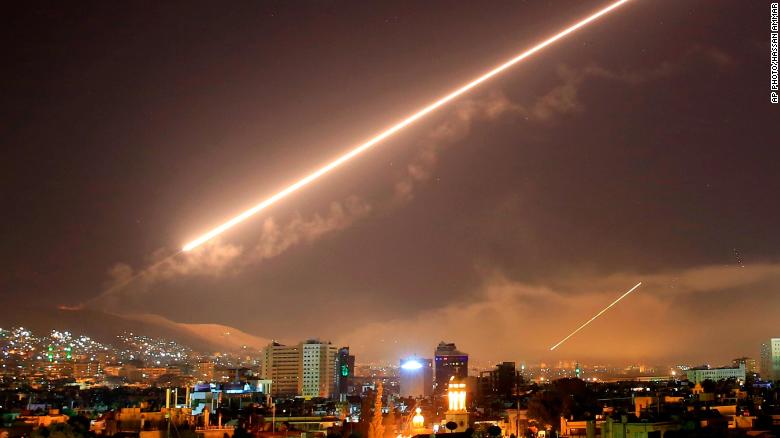The Bark That Warned, The Bite That Followed
"This was more about the western allies making sure their red lines were addressed rather than trying to seriously damage the Assad regime."
"From Assad's perspective, this was a big win. He must be thinking, this is good, I came out on top. I gained much more than I lost."
Amr al-Azm, professor of History, Shawnee University, Ohio
 |
| Still from video of strikes over Syria CNN |
"These limited strikes may serve to deter future chemical weapons use, but assuming they don't trigger escalation or a retaliation, they won't dramatically alter the course of the conflict."After all the tantalizing bluster that tripped out over the Internet and news reports of President Trump's irrepressible little thumb-twitchings on Twitter, the United States, France and United Kingdom organized themselves to deliver a hind-slap to Bashar al-Assad, hiding behind the chemical-weapons-denials of the Kremlin, with the Republic of Iran lurking in the background.
Emma Beals, war monitoring expert, Beirut
Three targets chosen, three targets hit. And a reprieve.
Launched by air and from naval platforms in the Red Sea, the Persian Gulf and the Eastern Mediterranean, it could have been a formidable force delivering a powerful message. But the trio satisfied itself by the delivery of a slap, meaningful in its messaging, but tolerable by the standards of those the message was forwarded to. The firecracker hissed, sparked and fizzled out.
Nothing more to see here, folks; move along.
The Barzah Research and Development Centre outside Damascus was hit with 76 missiles, the facility destroyed. According to the American military, Syria's chemical weapons capacities have been set back "for years". This, of an industry whose purpose is internationally outlawed and completely 'destroyed' not all that long ago under agreement between Vladimir Putin and Barack Obama.
"We deployed 105 weapons against three targets that will impact the Syrian regime's ability to develop, deploy and use chemical weapons in the future", announced Marine Corps Lt.-Gen.Kenneth McKenzie Jr., director of the Joint Staff. The destroyed facilities were "fundamental components of the regime's chemical warfare infrastructure".
Inspectors from the Organization for the Prohibition of Chemical Weapons visited the facility in 2017. Part of the Syrian Scientific Studies and Research Centre, it was characterized by the U.S. Treasury as "the Syrian government agency responsible for developing and producing non-conventional weapons and the means to deliver them." With a little help from his friends, Assad won't have any problems re-establishing this vital part of his military infrastructure.
It is not, after all, the structure and its purpose in and of itself that should be the target, but the man whose values of death-by-any-and-all-means-conceivable that destruction should have fallen upon. In the previous strike by the U.S. after a murderous sarin attack on civilians in Khan Sheikhoun, it was a military airfield that was attacked, and two days later warplanes were once again flying out of the base.
"[Syrians need a strategy leading to a political solution to] save them from the brutality of the Syrian regime."
Nasr al-Hariri, senior opposition leader
Labels: Atrocities, Britain, Chemical Weapons, Conflict, France, Rebels, Syria, United States
0 Comments:
Post a Comment
<< Home